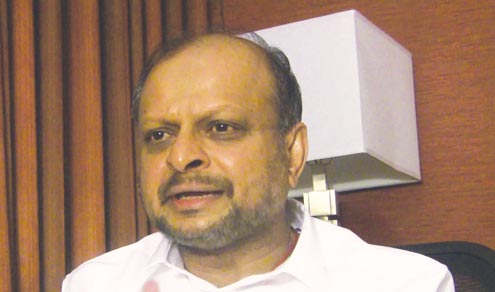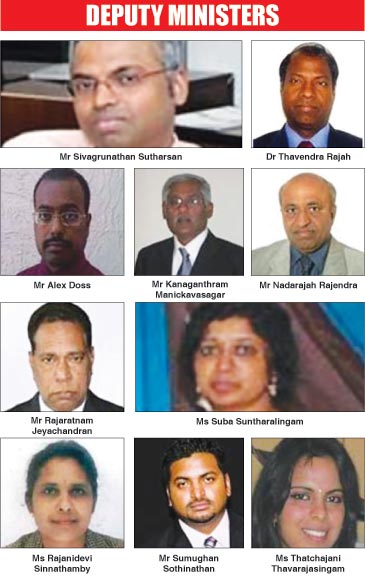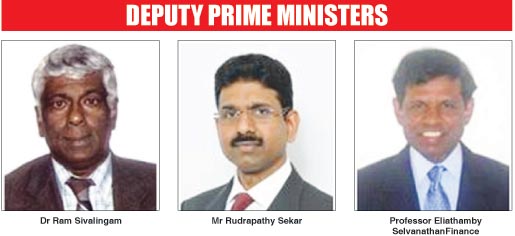
Sunday, 11 May 2014.
By Camelia Nathaniel
After the defeat of the LTTE in May 2009, the leaders of the LTTE rump attempted to replicate the organization in exile. As a segment of the Sri Lankan Tamil expatriates had spent much of lives supporting the crimes of murder, destruction and assassination by the LTTE, they were determined to not let their efforts go to waste.
Driven by an ideology of vengeance, they continued the fight for the restoration of the LTTE. The masterminds entrusted with this task were two of their most senior leaders living overseas.
LTTE Chief of Finance, Procurement and Shipping Selvarasa Pathmanathan alias Kumaran Pathmanathan alias KP and the LTTE’s International Legal Advisor Vishwanathan Rudrakumaran, who was in charge of its international and diplomatic affairs, consulted a few intellectuals who proposed the creation of the Transnational Government of Tamil Eelam (TGTE).

V.Rudrakumaran
TamilNet stated that the TGTE programme was set in motion during a meeting convened by KP in Kuala Lumpur in June 2009. He named V. Rudrakumaran as the Coordinator of the formation process and assisting him was a task group consisting of formation and advisory committees.
The first de facto leader of theTGTE was KP who was on Interpol’s ‘most wanted’ list for various crimes including arms smuggling and criminal conspiracy. He was also sought by India in connection with Rajiv Gandhi’s assassination in 1991. He was arrested in Malaysia on August 5, 2009 and deported to Sri Lanka.
Rudrakumaran coordinated the lawyers in the defense of LTTE cadres and activists accused in the suicide attack on Rajiv Gandhi, assisted in the defence of Suresh Manickavasagam, the LTTE Chief in Canada, and challenged the US decision to name the LTTE as a Foreign Terrorist Organization in 1997. Opposed to a negotiated settlement to the armed conflict between the LTTE and the Sri Lankan state, he represented the LTTE in peace talks with the Government of Sri Lanka.
KP sustained the killing machine of the LTTE while absconding in Malaysia and Rudrakumaran operated openly in the US seeking to legitimize LTTE actions. KP enabled Prabhakaran to perpetrate horrendous crimes against humanity and Rudrakumaran sought to justify his violence including massacres against innocent men, women and children in border villages, bombings of public places and suicide bombings of leaders, including two heads of government. After KP’s arrest, Rudrakumaran assumed leadership of TGTE. Both KP and Rudrakumaran came to the attention of the US government during a multinational intelligence investigation that targeted the LTTE network in the US.
Concerned that the LTTE was not only fundraising and procuring, the FBI identified LTTE supporters who were seeking to penetrate its political system and bribe State Department officials to delist the LTTE, etc. Working with their foreign counterparts, the FBI identified over one hundred American and foreign LTTE supporters, activists and directing figures. Although only the key leaders in US and Canadian procurement cells were arrested on US soil and a few extradited from Canada, others left for Tamil Nadu and Canada.
These persons included Father Jegath Gasperaj, the founder of the Tamil Maiyam, Tamil Nadu and Danton Thurairajah, Executive Director, Canadian Tamil Congress, Toronto. Both Gasperaj, a functionary of the LTTE and Thurairajah, a top LTTE fund raiser in the US worked under Karunakaran Kandasamy, the LTTE Chief in the US.
PTGTE

Rudrakumaran relied on the LTTE network and it overseas associates to create a committee for the formation of the Provisional Transnational Government of Tamil Eelam (PTGTE). He appointed an Advisory Committee (AC) of experts comprising both Diaspora Tamils and foreigners in 2009: Francis Boyle (USA), Joseph Chandrakanthan (Canada), Nagalingam Jeyalingam (USA), Jeyaprakash Jeyalingam (USA), Karen Parker (USA), Palaniappan Ramasamy (Malaysia), Peter Schalk (Sweden), Sivanendran Seevanayagam (Australia), Nadarajah Sriskandarajah (Sweden), Muttucumaraswamy Sornarajah (UK) and Amuthu Louis Vasanthakumar (UK)
The AC was tasked with exploring the modalities for the establishment of the TGTE, and formulate objectives that should be achieved by such an outfit.
The Committee decided the first step was the election of a ‘constituent assembly’. At the request of Rudrakumaran the AC organized Country Working Groups (CWG) to assist in the election process and the dissemination of information to expatriate communities.
The AC was keen to establish the PTGTE Secretariat in Geneva to coordinate the activities of the CWGs for two purposes: to infiltrate the human rights platforms in Geneva and use LTTE fronts to lobby both NGOs and governments especially western nations. The LTTE maintained a dedicated account called ‘Geneva’ and created its own human rights organizations. LTTE fronts such as the Global Tamil Forum, Australian Tamil Congress, the Canadian Tamil Congress, and the Tamil Youth Organization portrayed Prabhakaran and his cadres as freedom fighters.
In spite of the LTTE’s bloody and brutal history, the directing figures of the LTTE had long since realised the value of lobbying the West to bring pressure on the Sri Lankan government.
In October 2010, the PTGTE released the list of members of the CWGs in the US, Britain and Canada, and named the Coordinators of the CWGS in South Africa and Norway. Less than 10 percent of the Diaspora Tamils living overseas participated in the election of the TGTE. Even in Canada, where the LTTE openly indoctrinated the Tamil community, the voter turn out was low and some engaged in voter fraud. “The TGTE is elected from only among the LTTE supporters and sympathizers,” a Sri Lankan Tamil expatriate said, adding, “They are not elected from among the mainstream Tamils”.
Most of those appointed to the CWGs were tainted by the LTTE and PTGTE nominees had either advocated, supported or participated in terrorist activity. Some were LTTE members, and activists and some had even served time in jail.
For example, Anton S. Philip is the nom de guerre for Father Anton Sinnarasa, a Catholic Priest who was detained in Batticaloa in 1982 for laundering millions of rupees for the LTTE. This money had been robbed from a government bank in Neerveli. He is a member of the Canadian Country Working Group.
Like Father Emmanuel, Father Sinnarasa worked fulltime for the LTTE and earned the title ‘Godfather of the Canadian LTTE’. In classic LTTE-style, he operated a human rights NGO called War Victims and Human Rights (CHVHR), to disseminate propaganda and raise funds. Reincarnated as Anton S. Philips, he infiltrated the Tamil Eelam Society of Canada (TESOC), which received financial assistance from the Canadian Government, through the Ministry of Citizenship and Immigration. Through TESOC, LTTE activists provided resettlement services to and indoctrination of Tamil refugees arriving in Canada.
Neethan Shanmugaraja is an LTTE leader who assumed the name Neethan Shan. He ‘persuaded’ an entire generation of Tamil youth to support the LTTE which had been proscribed in Canada. Shan is the directing figure of the Tamil Youth Movement (TYO), designated as a ‘terrorist entity’ under the United Nations Security Council Resolution 1373. He held the post of National Director of the National Council of Canadian Tamils (NCCT), another organization designated as a ‘terrorist entity’ under UNSCR 1373. Although Neethan Shan has been careful to work in the shadows, he came within the radar of the authorities after he was nominated as the candidate fielded by the New Democratic Party of Canada, to contest the elections. Though unsuccessful many times over, he continued to receive NDP nomination for the Scarborough Rouge River district; this time for the forthcoming Ontario Provincial elections in June 2014.
TGTE

The TGTE’s Prime Minister Rudrakumaran is based in New York and his three deputies are based in Canada, UK and Australia. While the TGTE links the Tamil Diaspora communities worldwide, its structure also emulates the transnational nature of the TGTE.
Though the LTTE had been designated as a terrorist organization in 1997, Washington has not taken any action against the TGTE. The FBI has worked to monitor, suspend and curtail the activities of some of the LTTE’s fronts and sympathetic organizations such as the World Tamil Association (WTA), World Tamil Movement (WTM), The Federation of Associations of Canadian Tamils (FACT), and the Tamil Rehabilitation Organisation (TRO).
However, in May 2010, the US permitted one of its most hallowed premises to be used by the TGTE to host its inaugural assembly. The LTTE exploited US freedoms by hoisting the Tiger flag at the National Constitution Center in Philadelphia, where the original US constitution was signed.
Over the years a small number of US politicians have been lobbied by Tamil Diaspora groups linked to the LTTE, such as the United States Tamil Political Action Council (USTPAC), Federations of Tamil Associations of North America (FeTNA), Canadian Tamil Congress (CTC), etc. After its US network was disrupted by the FBI, the LTTE in North America organized and operated through the Ilankai Tamil Sangam, the New York Tamil Sangam and other Tamil Sangams.
Lobbying in the US was revived by Dr. Elias Jeyarajah, President of the US Tamil Political Action Council (USTPAC) and Grace Pushparani Williams using K Street lobby firm CJR to lobby policymakers and influencers. It is on public record that the Jeyarajah family gave US$ 10,965 to the Obama and Clinton campaigns in 2008. It is also reported that Dr. Jeyarajah had also personally donated US$ 1,565 to the Obama campaign, US$ 1,500 to the Clinton campaign and US$ 500 to the Democratic Party in North Carolina. It is also alleged that senior State Department officials had been contacted in order to garner support for action against Sri Lanka.
Tiger tactics
From the inception, the TGTE suffered from factional infighting due to power struggles. The very first TGTE election experienced voter fraud by rival factions of the LTTE. An expatriate Sri Lankan observed, “As the NCCT (National Council of CanadianTamils) engaged in rigging the vote, most Tamils kept away from the election”.
It cost candidates Canadian $ 3000 to register themselves to contest the TGTE elections. The money collected was not accounted for by the TGTE and was thus considered a money gouging exercise.
TGTE appointed ‘Deputy Commissioner of Elections’ Rajaratnam speaking about the integrity of the NCCT leaders, observed that the fraudulent election opened the eyes of the Tamil community. Rajaratnam reiterated that the elections made the Tamil public realise the dishonesty of their leaders.
Of the TGTE Assembly consisting of 135 members, 115 were to be elected and the remaining 20 would consist of delegates selected by the elected assembly to represent regions where elections aren’t feasible.
The distribution of the 115 elected representatives were from Australia 10; Benelux 3; Canada 25; Denmark 3; Finland 1; France 10; Germany 10; Ireland 1; Italy 3; New Zealand 2; Norway 3; South Africa 3; Sweden 1; Switzerland 10; UK 20; and USA 10. The distribution of the 20 appointed delegates were: Caribbean & South America 1; India 5; Malaysia 3; Mauritius 1; Middle East 2; Oceania 1; Rest of Africa 1; Rest of Asia 1; Rest of Europe 1; Singapore 2; and South Africa 2.
However, when it came to the elections, the TGTE practiced its Tiger tactics of autocratic leadership and not the envisaged collective leadership. When the voting for the TGTE assembly was held in New York in August 2010, the voting took place only on the question of whether there should be three regional deputies or not. While 42 voted in favour of deputies; 41 voted against.
There was another round of voting to decide whether the ‘prime minister’ as ‘supreme leader’ should nominate the three deputies or whether they should be elected by the Assembly. In this round, 46 were in favour while 43 were not.
During a third round of voting, on the question of the ‘prime minister’ appointing 7 cabinet ministers, there was no stiff opposition as 43 voted in favour, 28 opposed and 10 from Europe abstained in protest.
The proceedings in New York deemed illegal paved the way for a single ‘prime minister’ to dominate the whole structure of the TGTE. With splits within the LTTE, 46 out of 98 elected for the 135-member house personally participated in the proceedings in New York.
Factional fights
Since the beginning, there was a split between Oslo based Nediyavan and New York based Rudrakumaran. The genesis of the fight was a disagreement between KP (who was supported by Rudrakumaran) and Castro (who opposed Rudrakumaran in favour of his protégé Nediyavan).
The TamilNet supporting Nediyavan group claimed that those who didn’t come directly to New York were permitted to cast their votes from London (10 members) and Paris (17 members). While 2 members participated via Skype, 14 members had their votes cast by proxy and 9 members did not participate in the voting. On the second day, due to infighting between the Rudrakumaran and Nediyavan groups, some members walked out following a controversy over proxy voting.
The Nediyavan faction of the LTTE identified as ‘democrats’ of the TGTE were expelled by Rudrakumaran. Acting on behalf of Rudrakumaran in March 2011, the ‘speaker’ of the TGTE Assembly, Pon Balarajan alias Pon Balraj sent letters of expulsion to elected members of the TGTE who identified themselves as ‘Democrats’.
Due to infighting, between the Rudrakumaran and Nediyavan factions, half of the members of TGTE especially those in Canada resigned. Those who remained were considered black sheep by the Nediyavan Group’s Canada wing, the National Council of Canadian Tamils (NCCT). The NCCT was particularly angry that Pon Balraj became the speaker because he had eclipsed Thiru Thiruchelvam, a long standing LTTE activist.
Identity Cards
The issue of ID cards by the TGTE is seen as a ploy to gain the support of the Tamil community in terms of politics and finance. The TGTE requested the Tamil Diaspora to send their personal details and photographs along with 15 US$ in order to obtain ID cards.
While the TGTE is busy organizing media campaigns in most European capitals to promote the new IDs, the security and law enforcement agencies dealing with counter terrorism have expressed concern due to the track record of the LTTE. Many questions were raised by the Tamil Diaspora too as most of them have not forgotten how the LTTE, used personal information obtained by them to carry out various criminal activities both in Sri Lanka and overseas.
The issuance of ID cards by the LTTE for the Tamil Diaspora began in the late 90s where LTTE front offices issued ID cards in order to get every Diaspora member to contribute financially to strengthen its war coffers. This practice was introduced in Switzerland and later spread to other European countries as well, but had to be abandoned after the exposure of hidden criminality.
The LTTE not only used these ID cards to gain control over the Diaspora and raise funds for the organization but also used the personal data of the applicants to carry out illegal operations such as credit card fraud, money laundering and blackmail, etc. Some of the data was also used to produce forged Sri Lankan National ID cards in order to hide the identity of LTTE operatives particularly those who were assigned for suicide missions.
In some cases, personal data collected by the LTTE had subsequently been retrieved by the Security Forces. As a result, innocent Tamils had to undergo many hardships to prove their real identity and also to explain to the authorities how the said data was taken by LTTE overseas activists without their knowledge under the guise of issuing ID cards.
Now the TGTE led by Rudrakumaran is also following the same LTTE tricks to hoodwink the Tamil Diaspora, by introducing an ID card under the Eelam banner in order to expand its support base and ensure regular means of funding to meet their future expenses.
Some sections of the Diaspora observe that it is only a matter of time before the Nediyavan faction also follows suit
Tamil concerns or personal glory
The real question is whether these international pro LTTE factions are genuinely working for the affected Tamils in Sri Lanka or just fighting each other to promote their interests and personal agendas by hoodwinking the Diaspora Tamils. The LTTE failed after three decades of terrorism. Can these factions survive by continuing to use the same old tactics used by the LTTE at the expense of the Tamil community in Sri Lanka?
The decline and demise of the TGTE is inevitable with more Sri Lankan Tamils visiting the island and seeing for themselves the reality on the ground. Despite continuing efforts by the TGTE to propagate a racist ideology and offer ‘MP and Minister’ posts, there weren’t enough candidates who came forward to contest the 2013 elections. Many see Rudrakumaran as a charlatan and were not surprised when he was reprimanded by the US courts. On February 15, 2013 the United State Court of Appeals for the Second Circuit found that Rudrakumaran had engaged in ‘misconduct warranting discipline’ www.courtlistener.com/ca2/5cWX/in-re-rudrakumaran.
Many of those who joined Rudrakumaran left the TGTE due to the continuous infighting and personality differences. A Sri Lankan Tamil expatriate remarked: “In the 2013 election, whoever came forward to run was appointed a Member of the so called parliament of the TGTE. As the TGTE is controlled similar to the LTTE, most Tamils did not wish to be associated with a LTTE front, especially one based in the US”.




